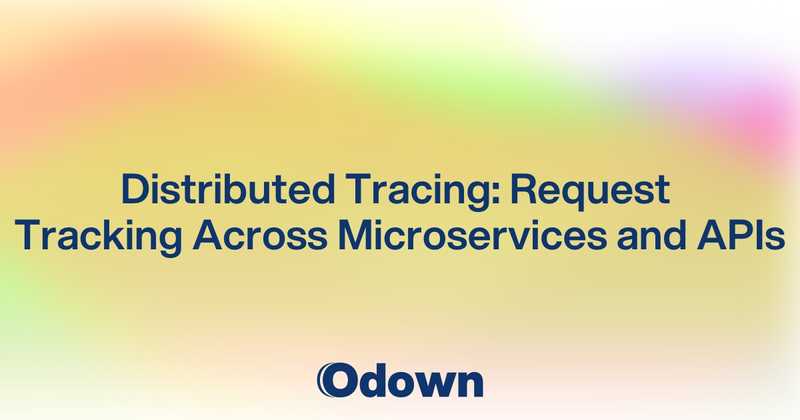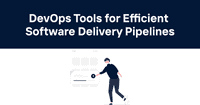Distributed Tracing: Request Tracking Across Microservices and APIs
A user clicks "buy now" and waits 10 seconds for the page to load. Your application metrics show everything is healthy---each microservice responds quickly, databases are fast, and APIs return sub-100ms response times. Yet somehow, the user experience is terrible, and you have no idea why.
This is the microservices monitoring blind spot. Traditional monitoring shows you how individual services perform, but it can't reveal what happens when a request bounces between 15 different services before reaching the user. One slow service in the chain destroys the entire user experience, but finding it feels like searching for a needle in a haystack.
Distributed tracing solves this problem by following individual requests through your entire system architecture. Instead of wondering which service is slow, you can see exactly how long each step takes and where bottlenecks occur.
Modern monitoring solutions include distributed tracing capabilities that help you understand complex service interactions. But implementing effective distributed tracing requires understanding trace data structures, instrumentation strategies, and analysis techniques.
Distributed Tracing Fundamentals: Spans, Traces, and Context Propagation
Distributed tracing introduces new concepts that require understanding before you can implement effective request tracking across complex systems.
Understanding Traces and Spans
The fundamental building blocks of distributed tracing create a hierarchical view of request processing:
Traces represent complete user requests from start to finish. A single trace might include dozens of spans across multiple services, showing the complete journey of a user action through your system architecture.
Spans represent individual operations within a trace. Each span has a start time, end time, and metadata about what operation was performed. Spans can be nested to show relationships between different operations.
Parent-child relationships between spans create the structure that makes distributed tracing valuable. A web request span might have child spans for database queries, external API calls, and internal service communications.
Context Propagation Mechanisms
For distributed tracing to work, trace context must travel with requests across service boundaries:
HTTP header propagation passes trace context through standard HTTP headers. Each service extracts trace context from incoming requests and includes it in outgoing requests to maintain the trace chain.
Message queue propagation ensures that asynchronous processing maintains trace context. When services communicate through message queues, trace context must be included in message metadata.
Database connection propagation can include trace context in database queries, helping correlate application performance with database operations. This is particularly valuable for identifying slow queries that affect user experience.
Sampling Strategies
Tracing every request in high-volume systems would overwhelm your infrastructure, so sampling strategies balance visibility with performance:
Head-based sampling makes sampling decisions when traces begin, ensuring consistent trace collection but potentially missing interesting traces that develop problems later.
Tail-based sampling makes decisions after traces complete, allowing you to prioritize traces with errors or unusual performance characteristics. This approach provides better signal-to-noise ratio but requires more complex infrastructure.
Adaptive sampling adjusts sampling rates based on current system conditions. Higher error rates or performance problems might trigger increased sampling to capture more diagnostic information.
Tracing Implementation: Jaeger, Zipkin, and OpenTelemetry Integration
Implementing distributed tracing requires choosing tools and integration strategies that work with your existing architecture while providing the visibility you need.
OpenTelemetry as the Foundation
OpenTelemetry has become the standard for distributed tracing instrumentation across different languages and platforms:
Language-specific SDKs provide consistent APIs for adding tracing to applications written in different programming languages. The same tracing concepts work whether you're using Go, Python, Java, or JavaScript.
Automatic instrumentation reduces the effort required to add tracing to existing applications. Many common frameworks and libraries include automatic tracing support that requires minimal configuration.
Manual instrumentation provides fine-grained control over what gets traced and how. Custom business logic, proprietary protocols, or performance-critical code paths might benefit from manual instrumentation.
Jaeger Implementation Strategies
Jaeger provides a complete distributed tracing platform with storage, analysis, and visualization capabilities:
Agent deployment strategies affect both performance and reliability. Jaeger agents can run as sidecars, host-level daemons, or be embedded directly in applications, each with different trade-offs.
Collector configuration determines how trace data flows from agents to storage systems. Proper collector configuration ensures trace data is reliably stored while maintaining system performance.
Storage backend optimization affects query performance and retention capabilities. Elasticsearch, Cassandra, and other storage backends have different performance characteristics for trace data.
Zipkin Integration Approaches
Zipkin offers a lighter-weight alternative that integrates well with existing monitoring infrastructure:
Transport protocol selection affects both performance and reliability. HTTP, Kafka, and other transport mechanisms have different characteristics for high-volume trace data.
Storage integration with existing systems can leverage your current monitoring infrastructure. Zipkin can store trace data in systems you already use for metrics and logs.
Compatibility considerations ensure that Zipkin integrates well with your existing monitoring tools and doesn't conflict with other observability systems.
Performance Bottleneck Identification Through Distributed Tracing
The real value of distributed tracing comes from identifying performance problems that are invisible to traditional monitoring approaches.
Service Dependency Analysis
Distributed tracing reveals how services depend on each other and where those dependencies create performance problems:
Critical path identification shows which services are on the critical path for user requests. Services that block user requests deserve more optimization attention than services that run asynchronously.
Dependency depth analysis reveals how many service hops are required for user requests. Deep service dependency chains create more opportunities for failures and performance problems.
Fan-out pattern analysis identifies services that make many parallel requests to other services. High fan-out patterns can overwhelm downstream services and create cascading performance problems.
Latency Breakdown Analysis
Understanding where time gets spent in distributed requests helps prioritize optimization efforts:
Service-level latency attribution shows how much time each service contributes to overall request latency. This information helps you focus optimization efforts on services that have the most user impact.
Operation-level analysis breaks down service time into specific operations like database queries, external API calls, or business logic processing. This granular view helps identify specific bottlenecks within services.
Wait time analysis identifies time spent waiting for resources versus time spent actively processing. High wait times might indicate resource contention, queue backups, or capacity issues.
Error Correlation and Impact
Distributed tracing helps understand how errors in one service affect the entire user experience:
Error propagation tracking shows how errors cascade through service dependencies. An error in a deep dependency might manifest as timeouts or degraded functionality in user-facing services.
Partial failure analysis identifies when some parts of a request succeed while others fail. Understanding partial failure patterns helps you build more resilient service architectures.
Error rate correlation with performance helps distinguish between errors that affect performance and errors that are handled gracefully without user impact.
Tracing Data Analysis: Finding Performance Issues in Complex Systems
Raw trace data becomes valuable through analysis techniques that identify patterns, trends, and anomalies in complex distributed systems.
Trace Aggregation and Pattern Analysis
Individual traces tell specific stories, but aggregated analysis reveals systemic patterns:
Service map generation creates visual representations of how services interact based on actual trace data. Service maps help you understand system architecture and identify potential optimization opportunities.
Latency percentile analysis across traces shows performance distribution rather than just averages. P95 and P99 latency measurements reveal how many users experience poor performance.
Error rate correlation analysis identifies services or operations that contribute disproportionately to system-wide error rates. Some services might have acceptable individual error rates but cause problems for dependent services.
Performance Trend Identification
Long-term analysis of trace data reveals performance trends that help with capacity planning and optimization:
Degradation detection identifies when service performance is gradually declining over time. Slow performance degradation might not trigger immediate alerts but indicates problems that need attention.
Seasonal pattern analysis reveals how performance characteristics change based on usage patterns, business cycles, or external factors. Understanding these patterns helps with capacity planning and performance expectations.
Deployment impact analysis correlates trace data with deployment events to understand how code changes affect system performance. This analysis helps identify problematic deployments and validate performance improvements.
Advanced Correlation Analysis
Sophisticated analysis techniques extract maximum value from trace data:
Business metric correlation links trace data with business outcomes like conversion rates, revenue, or user engagement. This correlation helps prioritize performance improvements based on business impact.
Infrastructure correlation combines trace data with infrastructure metrics to understand how system resource usage affects application performance. High CPU usage might correlate with increased trace latency in specific services.
External dependency impact analysis identifies how third-party services affect your system performance. External API latency, CDN performance, or database provider issues might create performance problems that appear internal.
Distributed tracing provides essential visibility for modern architectures but works best when integrated with other monitoring approaches. Log aggregation and analysis complement distributed tracing by providing detailed context about what happens within individual services.
Ready to implement comprehensive distributed tracing for your microservices architecture? Use Odown and gain the request-level visibility you need to optimize performance and maintain excellent user experience across complex distributed systems.



